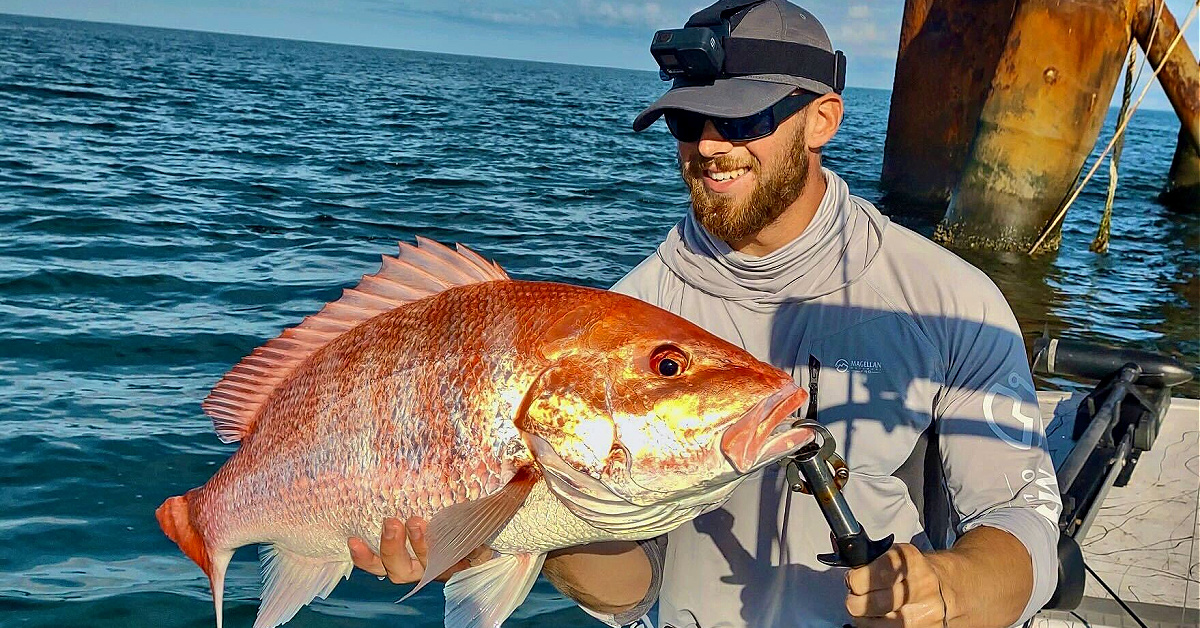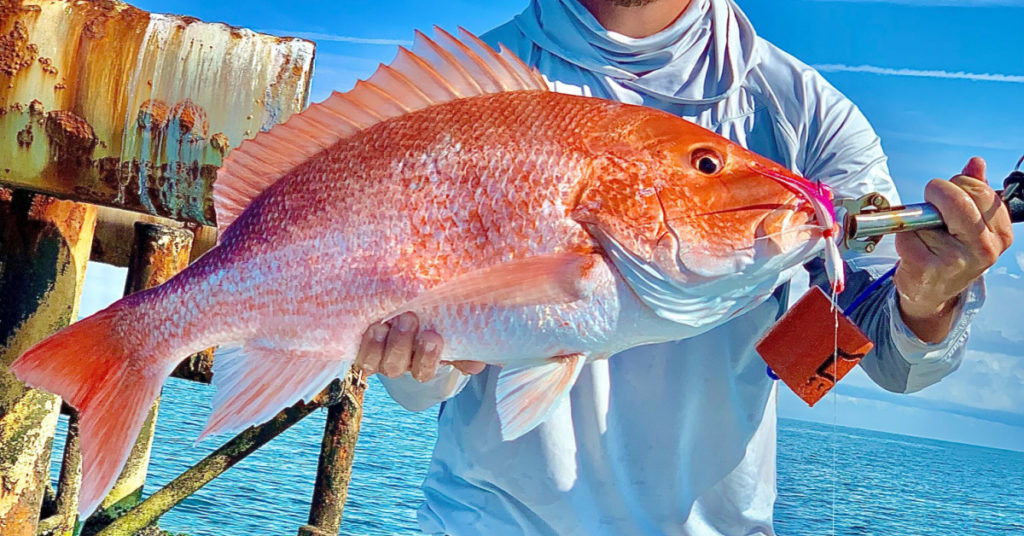Fishing Offshore In A Flats Boat (With Flats Fishing Gear)
- By: Wyatt Parcel
- on

Are you able to take a small flats boat offshore to target larger fish around underwater structures and oil rigs?
Under what conditions are the best time to do this type of fishing?
Check out this awesome trip to an oil rig for some offshore cobia and red snapper!
Learn m0re here!!
Fishing Offshore Structure In A Flats Boat



Fishing offshore oil rigs can produce lots of fish that like to hang tight to the structure where they feel comfortable.
It is worth setting a drift down current, away from the oil rig after testing out the rig itself.
Sometimes when you are out fishing the deep oil rigs, fish will move and set up down current.
Fishing offshore in a smaller vessel like a flats boat is definitely possible and can yield great results!
Be sure to pick your days right and find a nice, calm time to set out offshore and target larger fish around structures.
Fishing Offshore Structure In A Flats Boat [VIDEO]
Conclusion

Fishing offshore is limited to those that do not have the vessel to get them out there, but if you keep an eye on the weather and conditions, you can get yourself out there on a flats boat to catch big fish.
Oil rigs and structures provide places for fish to feed, feel safe, and hold throughout the year and are great places to bottom jig and hook into large fish.
Be sure to be safe and use proper judgment if you are going to fish offshore in a flats boat!!
Do you have any further questions on fishing offshore?
Let me know down in the comments!
And if you know someone who wants to learn more about fishing offshore, please TAG or SHARE this with them!
P.S. Want access to our best fishing spots and tips, plus discounts to our online tackle store? Click here to join us in the Insider Club!
Related Articles:
Related categories:
STOP WASTING TIME ON THE WATER!
Do what the “SMART ANGLERS” are doing and join the Insider Club.
Here’s what you’ll receive today when you join:
- Weekly fishing reports and TRENDS revealing exactly where you should fish every trip
- Weekly “spot dissection” videos that walk you through all the best spots in your area
- Exclusive fishing tips from the PROS you can’t find anywhere else
- Everything you need to start catching fish more consistently (regardless if you fish out of a boat, kayak, or land).










Ha Wyatt, as usual, great video. I would like to see you do a video about that boat. How you have it rigged, etc. for inshore fishing. I have a boat for offshore, on a nice day, but it is too big for inshore. I, and I am sure others, am interested in finding a small, simple, easy to rig and maintain,skiff that won’t deplete the grandkids college fund to buy.
I have been fishing offshore for years and at one time I dabbled in the charter business. Still have my USCG 100 ton license. Some things concerning safety needed to be added to this video. I have assisted in more than one offshore rescue scenario and things can get crazy out there quickly, even in a bigger boat. Any boat leaving site of land should have or do the following:
1) Functional VHF radio. A hand held is better than nothing but they work on line of sight so the Coast Guard may hear you but you wont be able to hear them. I have been the relay between a vessel with a poor VHF and the USCG before. There will be a protocol that involves communication from both parties. Get the tallest antennae you can reasonably put on your boat.
2) Back up GPS. My neighbor had an incident last week where their chart plotter quit and they almost didn’t find port. They had no back up. There are numerous apps you can get on your phone such as Inavix, Active Captain and Navionics. Have at least 2 separate GPS devices on board.
3) Ditch bag with supplies in case you get stranded. The sun is hot and dehydration and/or hypothermia can happen fast. You can find lists online of suggested items to include.
4) Follow the 1/3 out, 1/3 in and 1/3 reserve fuel rule. Know your burn and range. You need the extra 1/3 in case something happens such as a storm or getting lost where you cannot directly return to your port.
5) Be overly cautious of the weather. Numerous times I have seen the forecast say 1 foot or less and a storm pop up and turn that accurate forecast to six footers. Spring, Winter & Fall are not as bad as Summer but anything is possible. Radar, even the XM is helpful. I have used radar to run around cells to stay in calmer water. Radar is also a lifesaver if fog moves in on you.
6) Fishing the oil rig areas in a small boat requires you to always be on the look out for rogue waves from a crew boat. They are typically 3-4′ high and can travel for miles on a slick day. Had one break over my 17′ skiff one time and the only thing that saved me was seeing it and getting the bow turned into it with engine on before it hit me. Would have rolled me over had it hit me sideways. These boats are a daily routine in areas with oil rigs.
7) Consider an EPIRB.
8) Make sure you have an anchor with plenty of rode. If seas turn bad and the engine quits you will be at the mercy of the sea if you cannot anchor. You want your bow to the waves in most cases and the anchor will accomplish this.
9) Double check all your safety gear and fire extinguishers, bilge pumps, etc. I have been in a boat with an engine fire offshore and it is not fun. Also, and I am guilty of not doing this as I should, check your hoses going to anything below the water line. 17 miles offshore I picked up 5 people off a 23′ boat that had 9 total on it. A bigger boat sunk due to a hose breaking or coming loose off the smaller boat picked them up. USCG called for assistance as they were having trouble making it in with 2′ seas due to the number of people. I happened to be in the area. Had that boat not had a VHF they would have probably lost two boats that day.
10) Consider buddy boating for just as the reason above. Don’t let it make the go/no go decision but it does provide redundancy.
11) Consider buying a Goo Loo or similar battery booster. Often I leave my engine idling instead.
12) Lifejackets, flares, etc. are required for a reason. Make sure you have them.
I go 15 miles offshore in my 20′ center console but I have all the equipment mentioned above and watch the weather closely. Not trying to discourage anyone from heading offshore but I see so many boats, mostly small, operating in unsafe conditions offshore. Saw at least 3 boats in the fog Saturday about 15 miles out. I was in my 55 footer and none of them had on their nav lights, had radar or were operating the required fog signals. Lucky for them I saw them on radar but I think one of them had to clean their pants when my boat appeared out of the fog less than 200′ away. It was flat calm but still unsafe to be out without proper equipment. End of rant but I hope it helps someone avoid becoming a statistic. Remember Gilligan’s Island was discovered on a 3 hour tour.
2 GPS’s , watch the weather, Have fun. I also have a 100 ton 200nm continental us.
excellent post Brian — I copied/saved it for my records. I have a 20ft Grady White w/~650 hours on the engine, and let’s just say I am working my way up to going offshore for the first time. Not sure I will ever get there but this post will serve as an excellent checklist, thanks
Really good info ,Thanks for the post.
I met a gentleman and his wife in the Bahamas 2 years ago who had traveled across from West Palm in their 17′ Key West Flats boat. (I know that boat I have one) Yes you can do if the conditions are right and you have emergency equipment, boat is in perfect condition, and you know how to handle the waves in the boat. However, this is not for the newbie boater or even someone with limited experience. You have to research the long term weather conditions and not for the next 4 hours. Timings of fronts change quickly sometimes We went out one spring morning and it was flat. Weather forecast was 2′ We were in our 25′ Mako. Suddenly the wind shifted to NE, temp dropped, and seas built QUICKLY to 8′ with waves breaking over the starboard rail and sometimes bow. We had headed out on a course of 119 degrees. When I plugged in home in the Loran (yes that was how long ago) It told me our course home was 0 degrees. Yes the wind was blowing so hard instead of 299 reciprocal our course was 360.— 61 degrees off what should have been our reciprocal. We had only 10 miles to go back home but it was the most wet miserable ride I recall in my lifetime of fishing. Max speed was 5 knots in those conditions.5 souls on board 3 under 14. everyone in life vests and the kids laying on the deck in the bow to try and keep as much water off them as possible. Almost hypothermia for two of us at helm (my buddy was ex-Navy and afraid I was going to be swept overboard and was crouched down beside me to make sure I didn’t go over). I was cold, wet, shivering, and worried I had 3 kids on board in these conditions. We were all dressed in shorts & Cotton T’s. I received the brunt of waves while piloting homes. We all had rain gear stored on the boat but I was drenched with each wave, even with rain gear. (another lesson learned – full blown rain gear purchased immediately afterwards for each member on board – not ponchos or light rain clothing – like we had) Arrived safely after 2 hours. We anchored in a cove stripped off wet outer clothes and laid in the sun to warm up and dry out. Not an experience I want to repeat again. Oh, the weather station said the seas were two feet! That day taught my sons a serious lesson in offshore boater safety. They have not forgotten. Now with their own boats they look at long term weather conditions to be sure – not just taking with the weather service says.
Not to be a kill-joy here on a forum I really enjoy, but lots of things can go wrong 15 miles out in a small, shallow draft boat. Can you do it? — yes, of course, but you definitely better know the weather at all times and know exactly what you will do in an emergency. Even a pop up storm can cause a major problem in that boat. Happy for your results, but not for me personally. There’s plenty of inshore water for that boat.
Way to go Wyatt , nice fish. Are those in season they looked mighty tasty
Unfortunately they are not! Red Snapper are delicious, but their seasons aren’t terribly long, and there’s actually an early closure here in TX right now (that will reopen in state waters only in January)
If you have the experience and really know what your doing I agree. Any one who has not been around the horn a few times might want to stay close in until they gain the experience. Have you ever been there when someone drown, not fun been there. So always, always put safety first and know your limits. Enjoy and be safe!
Absolutely. It took me 15 or so trips before I was comfortable going past 3 or so miles. Taking it slow and learning how to do things the right way is necessary out there!
I have ran up to 50 miles offshore in my 22’ bay boat. Anything over 2’ isn’t much fun. I pick my days and watch the weather closely. I’d highly recommend a good vhf and especially an epirb or plb if venturing offshore. I have my beacon affixed to my vest when offshore.
I agree with that! Safety first! Thanks for watching Lyle!
Of course I won’t talk about when I was young and would go out into the Gulf Stream off of Elliott Key in S. Fl in a Jon boat with a 10hp outboard…
Great, fun video. “…and I do believe there’s gonna be some Cobia active on the rig”. Ha! So goes fishing. Not that there’s anything wrong with those gorgeous reds you caught, but in the world of fishing, well, the best laid plans sometimes mean nothing! Lol. Thanks for sharing, that looked like a fun and relaxing trip (aside from the forearm workouts). Later!
Absolutely true! I love calling my shot, and have been lucky a few times, but I wasn’t upset when those big red snappers proved me wrong! Thanks so much for watching Matt!
Hey, every now and again we each get to enjoy our own Joe Namath moment. Not often, but sometimes!
I like using a 300 bait caster offshore for red snapper. They’re actually quite perfect for that.
Hey, that’s my spot in Alabama….
They’re a workhorse of a reel! My friend who was with me (who’s a retired sailfish captain) prefers them for light tackle offshore reels.
Awesome job Wyatt! Those were some stud red snappers!
Thanks so much Pat!! Glad you enjoyed this one sir… can’t wait to get you down here in TX!